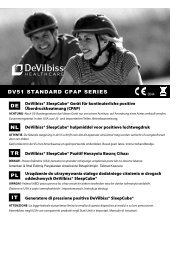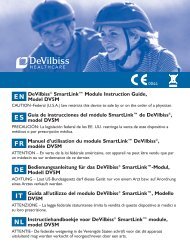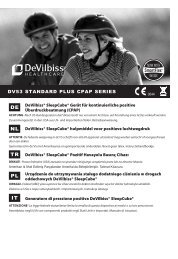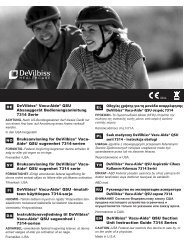DeVilbiss® Vacu-Aide® QSU Absauggerät Bedienungsanleitung ...
DeVilbiss® Vacu-Aide® QSU Absauggerät Bedienungsanleitung ...
DeVilbiss® Vacu-Aide® QSU Absauggerät Bedienungsanleitung ...
Create successful ePaper yourself
Turn your PDF publications into a flip-book with our unique Google optimized e-Paper software.
Immunity Test IEC 60601 Test Level Compliance Level Electromagnetic Environment - Guidance<br />
Electrostatic Discharge<br />
(ESD) IEC 61000-4-2<br />
Electrical Fast Transient/<br />
burst IEC 61000-4-4<br />
Surge<br />
IEC 61000-4-5<br />
Voltage dips, short<br />
interruptions and voltage<br />
variations on power supply<br />
input lines IEC 61000-4-11<br />
Power Frequency 50/60Hz<br />
Magnetic Field<br />
IEC 61000-4-8<br />
Conducted RF<br />
IEC 61000-4-6<br />
Radiated RF<br />
IEC 61000-4-3<br />
±6kV contact<br />
±8kV air<br />
±6kV contact<br />
±8kV air<br />
Floors should be wood, concrete or ceramic tile. If floors are synthetic, the relative<br />
humidity should be at least 30%.<br />
±2kV on AC Mains ±2kV on AC Mains Mains power quality should be that of a typical commercial or hospital environment.<br />
±1kV Differential<br />
±2kV Common<br />
>95% Dip for 0.5 Cycle<br />
60% Dip for 5 Cycles<br />
30% Dip for 25 Cycles<br />
>95% Dip for 5 Seconds<br />
3A/m<br />
3 Vrms from<br />
150 kHz to 80 MHz<br />
3 V/m<br />
80 MHz to 2.5 GHz<br />
±1kV Differential<br />
±2kV Common<br />
>95% Dip for 0.5 Cycle<br />
60% Dip for 5 Cycles<br />
30% Dip for 25 Cycles<br />
>95% Dip for 5 Seconds<br />
3A/m<br />
3 Vrms<br />
3V/m<br />
Mains power quality should be that of a typical commercial or hospital environment.<br />
Mains power quality should be that of a typical commercial or hospital environment.<br />
If the user of this device requires continued operation during power mains<br />
interruptions, it is recommended that the device be powered from an uninterruptible<br />
power supply or battery.<br />
Power frequency magnetic fields should be that of a typical location in a typical<br />
commercial or hospital environment.<br />
Portable and mobile RF communications equipment should be separated from the<br />
device by no less than the recommended separation distances calculated/listed<br />
below:<br />
D=(1.2)√P<br />
D=(1.2)√P 80 to 800 MHz<br />
D=(2.3)√P 800 MHz to 2.5 GHz<br />
Where P is the maximum power rating in watts and D is the recommended<br />
separation distance in meters.<br />
Field strengths from fixed transmitters, as determined by an electromagnetic site<br />
survey, should be less than the compliance levels (3 Vrms and 3V/m).<br />
Interference may occur in the vicinity of equipment containing a transmitter.<br />
For transmitters rated at a maximum output power not listed above, the recommended separation distance D in meters (m) can be estimated using the equation applicable<br />
to the frequency of the transmitter, where P is the maximum output power rating of the transmitter in watts (W) according to the transmitter manufacturer.<br />
Note 1: At 80 MHz and 800 MHz, the separation distance for the higher frequency range applies.<br />
Note 2: These guidelines may not apply in all situations. Electromagnetic propagation is affected by absorption and reflection from structures, objects, and people.<br />
Recommended Separation Distances Between Portable and Mobile RF Communications Equipment and<br />
this device. This device and system are NOT Life-Supporting<br />
This device is intended for use in the electromagnetic environment in which radiated disturbances are controlled. The customer or user of this device can help prevent<br />
electromagnetic interference by maintaining a minimum distance between portable and mobile RF Communications Equipment and the device as recommended below,<br />
according to the maximum output power of the communications equipment.<br />
Recommended Separation Distances for the device (meters)<br />
Maximum Output Power 150 kHz to 80 MHz 80 to 800MHz<br />
800 MHz to 2.5 GHz<br />
(Watts)<br />
D=(1.2)√P<br />
D=(1.2)√P<br />
D=(2.3)√P<br />
0.01 0.12 0.12 0.23<br />
0.1 0.38 0.38 0.73<br />
1 1.2 1.2 2.3<br />
10 3.8 3.8 7.3<br />
100 12 12 23<br />
For transmitters rated at a maximum output power not listed above, the recommended separation distance D in meters (m) can be estimated using the equation applicable<br />
to the frequency of the transmitter, where P is the maximum output power rating of the transmitter in watts (W) according to the transmitter manufacturer.<br />
Note 1: At 80 MHz and 800 MHz, the separation distance for the higher frequency range applies.<br />
Note 2: These guidelines may not apply in all situations. Electromagnetic propagation is affected by absorption and reflection from structures, objects, and people.<br />
A-7314<br />
EN - 81






